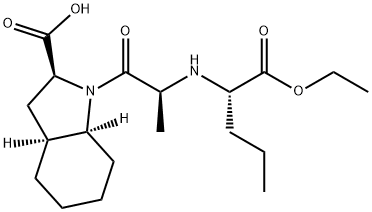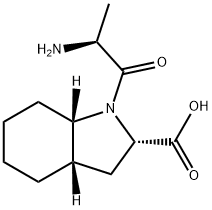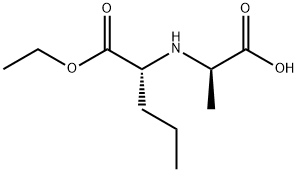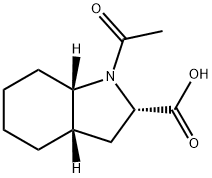Perindopril
- CAS NO.:82834-16-0
- Empirical Formula: C19H32N2O5
- Molecular Weight: 368.47
- MDL number: MFCD00865859
- EINECS: 617-394-0
- SAFETY DATA SHEET (SDS)
- Update Date: 2025-08-21 22:16:43

What is Perindopril?
Absorption
Rapidly absorbed with peak plasma concentrations occurring approximately 1 hour after oral administration. Bioavailability is 65-75%. Following absorption, perindopril is hydrolyzed to perindoprilat, which has an average bioavailability of 20%. The rate and extent of absorption is unaffected by food. However, food decreases the extent of biotransformation to peridoprilat and reduces its bioavailability by 35%.
Toxicity
The most likely symptom of overdose is severe hypotension. The most common adverse effects observed in controlled clinical trials include cough, digestive symptoms, fatigue, headache, and dizziness.
Description
Perindopril is a potent, orally-active angiotensin-converting enzyme (ACE) inhibitor useful in the management of hypertension. Against rat ACE, perindopril appears to be more potent than enalapril and enalaprilat, and is approximately equipotent to rarnipril (HOE 498). Its long duration of action suggests the possibility of once-daily dosing.
Description
Perindopril is a long-acting angiotensin-converting enzyme (ACE) inhibitor that is used to treat cardiovascular conditions. It is commercially available as arginine and tert-butylamine (also known as erbumine) salts. This year, M. Teresa Duarte and her colleagues in Portugal used single-crystal X-ray diffraction spectroscopy to determine the structures of two perindopril erbumine polymorphs and a previously unknown hydrated form.
Chemical properties
Light Pink Solid
Originator
Servier (France)
The Uses of Perindopril
Labeled Perindopril, intended for use as an internal standard for the quantification of Perindopril by GC- or LC-mass spectrometry.
The Uses of Perindopril
An angiotensin-converting enzyme (ACE) inhibitor. Antihypertensive. Neuroprotective & Neuroresearch Product.
Background
Perindopril is a nonsulfhydryl prodrug that belongs to the angiotensin-converting enzyme (ACE) inhibitor class of medications. It is rapidly metabolized in the liver to perindoprilat, its active metabolite, following oral administration. Perindoprilat is a potent, competitive inhibitor of ACE, the enzyme responsible for the conversion of angiotensin I (ATI) to angiotensin II (ATII). ATII regulates blood pressure and is a key component of the renin-angiotensin-aldosterone system (RAAS). Perindopril may be used to treat mild to moderate essential hypertension, mild to moderate congestive heart failure, and to reduce the cardiovascular risk of individuals with hypertension or post-myocardial infarction and stable coronary disease.
Indications
For the treatment of mild to moderate essential hypertension, mild to moderate congestive heart failure, and to reduce the cardiovascular risk of individuals with hypertension or post-myocardial infarction and stable coronary disease.
What are the applications of Application
Perindopril is an ACE inhibitor
Definition
ChEBI: Perindopril is an alpha-amino acid ester that is the ethyl ester of N-{(2S)-1-[(2S,3aS,7aS)-2-carboxyoctahydro-1H-indol-1-yl]-1-oxopropan-2-yl}-L-norvaline It has a role as an EC 3.4.15.1 (peptidyl-dipeptidase A) inhibitor and an antihypertensive agent. It is an alpha-amino acid ester, a dicarboxylic acid monoester, an organic heterobicyclic compound and an ethyl ester. It is a conjugate acid of a perindopril(1-).
Manufacturing Process
Heat 5 kg of 2-carboxyindole suspended in ethanol in the presence of sulfuric acid to boiling for 8 hours. Evaporate off take up the crystalline mass with hexane. After filtering off and drying, 5.3 kg of 2-ethoxycarbonylindole crystals are obtained. Melting point: 123°-125°C.
Suspend, in a reactor, 10 kg of 2-ethoxycarbonylindoline obtained previously in 110 liters of hydrochloric ethanol. Next, add 20 kg of granulated tin. Keep stirring for approximately 2 days at room temperature. Evaporate off the ethanol, take up the residue with water and add 110 liters of toluene. Stir for approximately 20 min. Alkalify with aqueous ammonia. Separate off the aqueous phase and extract once again with 150 liters of toluene. Combine the toluene phases and wash them with water. Separate off the toluene phases, filter. Remove the water by distilling the water-toluene azeotrope. Cool and pass through a stream of anhydrous HCl gas. Cool. Evaporate down and wash with pure toluene. Weight obtained of (R,S)-2-ethoxycarbonylindoline 10.11 kg. Yield: 84%.
2.15 kg of (R,S)-2-ethoxycarbonylindoline dissolved in ethanol are saponified with 12.5 liters of sodium hydroxide with stirring for 24 hours. After washing the alkaline solution, neutralize with concentrated hydrochloric acid. After filtering off, washing and drying, 1.57 kg of white crystals of the (R,S)-2carboxyindoline are obtained. Yield: 86%. Melting point: 188°-189°C.
6.05 kg of (R,S)-2-carboxyindoline are added to a solution of 4.49 kg of (+)α-methylbenzylamine in anhydrous ethanol. A white precipitated product is obtained which, after filtering off, is digested in refluxing isopropanol. After cooling, the solid is filtered off and washed with a little isopropanol. 1 kg of the obtained salt was dissolved in 5 liters of water and neutralizing with an aqueous hydrochloric acid solution. The precipitate is filtered off, washed with water and dried and (S)-2-carboxyindoline was prepared.
Place 25 kg of (S)-2-carboxyindoline, obtained previously, in 110 liters of methanol in a vessel. Keep stirred. Charge the rhodium (5% dry) catalyst into a mixer. Start up the stirring in a hydrogenator, charge the methanolic suspension of (S)-2-carboxyindoline by passing it through the mixer and rinse the assembly with water. Heat to 60°C and pressurize with hydrogen (30 bars). Filter off the catalyst on a single-plate filter. Collect the hydroalcoholic liquors in a reactor and evaporate the methanol off under vacuum. After concentrating, charge approximately 300 kg of dioxane. Heat to boiling and add water until a solution is obtained. Allow to cool. Filter off and dry. 22.3 kg of crystals of (2S,3aS,7aS)-2-carboxyoctahydroindole are obtained. Yield: 86.1%.
Place 35 kg of L-norvaline in approximately 300 kg of denatured ethanol in a reactor. Introduce approximately 60 kg of thionyl chloride, slowly and gradually. After stirring for a quarter of an hour, heat to reflux for 3 hours andthen evaporate off the ethanol under vacuum. Take up the residue with 300 liters of cyclohexane and heat to boiling. Allow to cool, filter, wash with cyclohexane and dry. 52.9 kg of ethyl L-norvalinate hydrochloride are obtained, that is a 97.6% yield.
Place 45 kg of ethyl N-norvalinate hydrochloride approximately 110 liters of water in a vessel equipped with a stirrer. Alkalify, then pour 23 kg of pyruvic acid very gradually into the solution obtained previously and stir the reaction mixture for 30 min. Place an aqueous suspension of charcoal containing 5% palladium and the alkaline solution of ethyl L-norvalinate obtained previously in a hydrogenation apparatus. Hydrogenate under pressure (30 bars) at room temperature for approximately one day. Filter under vacuum and evaporate the filtrate under reduced pressure, filter off and dry. Treat the residue obtained with ethanol; remove the insoluble material, consisting of sodium chloride, by filtration and rinse it with ethanol. Combine the ethanolic solutions; evaporate off the ethanol under reduced pressure and crystallize the residue from acetonitrile 34.3 kg of N-[(S)-1-carbethoxybutyl]-(S)-alanine are obtained, that is a 63.9% yield.
In a 30-liter reactor, reflux 12.5 kg of (2S,3aS,7aS)-2-carboxyperhydroindole, 50 kg of para-toluenesulfonic acid and 14.2 kg of benzyl alcohol and 38.4 kg of toluene, removing the water formed with the aid of a continuous separator. When no more water separates out, cool, filter off the precipitate of paratoluenesulfonate of the benzyl ester of (2S,3aS,7aS)-2carboxyoctahydroindole formed, and dry. Yield: 91.3%.
Add approximately 3.5 kg of triethylamine to a suspension of approximately 5 kg of para-toluenesulfonate of the benzyl ester of (2S,3aS,7aS)-2carboxyoctahydroindole in approximately 60 kg of ethyl acetate, followed by approximately 6 kg of 1-hydroxybenzotriazole, approximately 7.5 kg of the N[(S)-1-carbethoxybutyl]-(S)-alanine and approximately 7.0 kg of dicyclohexylcarbodiimide. Stir, cooling slightly for approximately 3 hours, then filter off the dicyclohexylurea formed and wash the organic phase with water. The dried organic phase is evaporated to dryness and benzyl ester of (2S,3aS,7aS)-1-{2-[1-(ethoxycarbonyl)-(S)-butylamino]-(S)propionyl}octahydroindole-2-carboxylic acid was obtained. Yield: 92.3%.
Dissolve, in a hydrogenator, 14 kg of benzyl ester of the (2S,3aS,7aS)-1-{2[1-(ethoxycarbonyl)-(S)-butylamino]-(S)-propionyl}octahydroindole-2carboxylic acid in cyclohexane. Add the charcoal containing 5% palladium and approximately 50 liters of water. Hydrogenate at ordinary temperature and pressure until the theoretical volume of hydrogen has been absorbed. Filter, wash the insoluble material with cyclohexane, separate off the organic phase and wash the aqueous phase again with cyclohexane. Isolate the (2S,3aS,7aS)-1-{2-[1-(ethoxycarbonyl)-(S)-butylamino]-(S)propionyl}octahydroindole-2-carboxylic acid from the aqueous phase by freeze-drying.
In practice it is used combined with 2-methyl-2-propanamine.
brand name
Coversyl
Therapeutic Function
Antihypertensive
Pharmacokinetics
Perindopril is a nonsulfhydryl prodrug that is metabolized via first pass effect (62%) and systemic hydrolysis (38%) to perindoprilat, its active metabolite, following oral administration. Perindoprilat lowers blood pressure by antagonizing the effect of the RAAS. The RAAS is a homeostatic mechanism for regulating hemodynamics, water and electrolyte balance. During sympathetic stimulation or when renal blood pressure or blood flow is reduced, renin is released from the granular cells of the juxtaglomerular apparatus in the kidneys. In the blood stream, renin cleaves circulating angiotensinogen to ATI, which is subsequently cleaved to ATII by ACE. ATII increases blood pressure using a number of mechanisms. First, it stimulates the secretion of aldosterone from the adrenal cortex. Aldosterone travels to the distal convoluted tubule (DCT) and collecting tubule of nephrons where it increases sodium and water reabsorption by increasing the number of sodium channels and sodium-potassium ATPases on cell membranes. Second, ATII stimulates the secretion of vasopressin (also known as antidiuretic hormone or ADH) from the posterior pituitary gland. ADH stimulates further water reabsorption from the kidneys via insertion of aquaporin-2 channels on the apical surface of cells of the DCT and collecting tubules. Third, ATII increases blood pressure through direct arterial vasoconstriction. Stimulation of the Type 1 ATII receptor on vascular smooth muscle cells leads to a cascade of events resulting in myocyte contraction and vasoconstriction. In addition to these major effects, ATII induces the thirst response via stimulation of hypothalamic neurons. ACE inhibitors inhibit the rapid conversion of ATI to ATII and antagonize RAAS-induced increases in blood pressure. ACE (also known as kininase II) is also involved in the enzymatic deactivation of bradykinin, a vasodilator. Inhibiting the deactivation of bradykinin increases bradykinin levels and may sustain the effects of perindoprilat by causing increased vasodilation and decreased blood pressure.
Clinical Use
Angiotensin-converting enzyme inhibitor:
Hypertension
Heart failure
Following myocardial infarction or revascularisation
Drug interactions
Potentially hazardous interactions with other drugs
Anaesthetics: enhanced hypotensive effect.
Analgesics: antagonism of hypotensive effect and
increased risk of renal impairment with NSAIDs;
hyperkalaemia with ketorolac and other NSAIDs.
Antihypertensives: increased risk of hyperkalaemia,
hypotension and renal failure with ARBs and
aliskiren.
Bee venom extract: possible severe anaphylactoid
reactions when used together.
Ciclosporin: increased risk of hyperkalaemia and
nephrotoxicity.
Cytotoxics: increased risk of angioedema with
everolimus.
Diuretics: enhanced hypotensive effect;
hyperkalaemia with potassium-sparing diuretics.
ESAs: increased risk of hyperkalaemia; antagonism
of hypotensive effect.
Gold: flushing and hypotension with sodium
aurothiomalate.
Lithium: reduced excretion (possibility of enhanced
lithium toxicity).
Potassium salts: increased risk of hyperkalaemia.
Tacrolimus: increased risk of hyperkalaemia and
nephrotoxicity.
Metabolism
Extensively metabolized, with only 4-12% of the dose recovered in urine following oral administration. Six metabolites have been identified: perindoprilat, perindopril glucuronide, perindoprilat glucuronide, a perindopril lactam, and two perindoprilat lactams. Only perindoprilat is pharmacologically active. Peridoprilat and perindoprilat glucuronide are the two main circulating metabolites.
Metabolism
Perindopril is a pro-drug. It is extensively metabolised, mainly in the liver, to the active perindoprilat and inactive metabolites including glucuronides. Perindopril is excreted mainly in the urine, as unchanged drug, as perindoprilat, and as other metabolites.
References
[1] ryuji yasumatsu, torahiko nakashima, muneyuki masuda, aya ito, yuichiro kuratomi, yuichiro kuratomi and shizuo komune. effects of the angiotensin-i converting enzyme inhibitor perindopril on tumor growth and angiogenesis in head and neck squamous cell carcinoma cells. j cancer res clin oncol. 2004, 130: 567–573.
[2] a.a.ajayi, k.r.lees and j.l.reid. effects of angiotensin converting enzyme inhibitor, perindopril, on autonomic reflexes. eur j clin pharmacol. 1986, 30:177-182.
Properties of Perindopril
| Melting point: | 100-101°C |
| Boiling point: | 537.4±45.0 °C(Predicted) |
| Density | 1.150±0.06 g/cm3(Predicted) |
| storage temp. | -20°C Freezer |
| solubility | Chloroform (Slightly), Methanol (Slightly) |
| form | Solid |
| pka | 3.15±0.20(Predicted) |
| color | White to Off-White |
| CAS DataBase Reference | 82834-16-0(CAS DataBase Reference) |
Safety information for Perindopril
| Signal word | Warning |
| Pictogram(s) |
 Exclamation Mark Irritant GHS07 |
| GHS Hazard Statements |
H302:Acute toxicity,oral H315:Skin corrosion/irritation H319:Serious eye damage/eye irritation H335:Specific target organ toxicity, single exposure;Respiratory tract irritation |
| Precautionary Statement Codes |
P261:Avoid breathing dust/fume/gas/mist/vapours/spray. P280:Wear protective gloves/protective clothing/eye protection/face protection. P301+P312:IF SWALLOWED: call a POISON CENTER or doctor/physician IF you feel unwell. P302+P352:IF ON SKIN: wash with plenty of soap and water. P305+P351+P338:IF IN EYES: Rinse cautiously with water for several minutes. Remove contact lenses, if present and easy to do. Continuerinsing. |
Computed Descriptors for Perindopril
New Products
4,4-Difluoropiperidine hydrochloride tert-butyl 9-methoxy-3-azaspiro[5.5]undecane-3-carboxylate Indole Methyl Resin N-Isopropylurea N,N-Dicyclohexylcarbodiimide(DCC) MELDRUMS ACID 5-METHYLISOXAZOLE-4-CARBOXYLIC ACID Magnessium Bis glycinate Zinc ascorbate 1-bromo-2-butyne 2-acetamidophenol 9(10H)-anthracenone Erythrosin B, 4-Piperidinopiperidine 2-((4-morpholinophenylamino) (methylthio) methylene) malononitrile 2,4-dihydroxybenzaldehyde 3-(4-morpholinophenylamino)-5-amino-1H-pyrazole-4-carbonitrile Methyl 2-methylquinoline-6-carboxylate 2,6-dichloro-4-nitropyridine 4-Bromo-2-chlorobenzonitrile 2-(benzylamino)acetic acid hydrochloride 4-(tert-Butoxycarbonylamino)but- 2-ynoic acid 3,4-dihydro-2H-benzo[b][1,4]dioxepine 1-Phenyl-1-cycloprppanecarboxylicacidRelated products of tetrahydrofuran







![(S)-Ethyl 2-((3S,5aS,9aS,10aS)-3-methyl-1,4-dioxodecahydropyrazino[1,2-a]indol-2(1H)-yl)pentanoate ,95%](https://img.chemicalbook.in/CAS/GIF/129970-98-5.gif)
You may like
-
 82834-16-0 Perindopril 98%View Details
82834-16-0 Perindopril 98%View Details
82834-16-0 -
 Perindopril 97%View Details
Perindopril 97%View Details -
 Perindopril 95.00% CAS 82834-16-0View Details
Perindopril 95.00% CAS 82834-16-0View Details
82834-16-0 -
 3-(4-amino-1-oxoisoindolin-2-yl)-1-methylpiperidine-2,6-dione 98%View Details
3-(4-amino-1-oxoisoindolin-2-yl)-1-methylpiperidine-2,6-dione 98%View Details -
 20677-73-0 (2,2-diethoxyethyl)methylamine 98%View Details
20677-73-0 (2,2-diethoxyethyl)methylamine 98%View Details
20677-73-0 -
 3-(4-(hydroxyamino)-1-oxoisoindolin-2-yl)piperidine-2,6-dione 98%View Details
3-(4-(hydroxyamino)-1-oxoisoindolin-2-yl)piperidine-2,6-dione 98%View Details -
 57381-49-4 2-bromo-4-chlorobenzonitrile 98%View Details
57381-49-4 2-bromo-4-chlorobenzonitrile 98%View Details
57381-49-4 -
 4,6-dichloropyrimidine-5-carbaldehyde 98%View Details
4,6-dichloropyrimidine-5-carbaldehyde 98%View Details
5305-40-8
